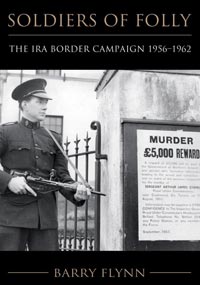17 December 2009 Edition
Useful narrative of '50s campaign

Book Review
Soldiers of Folly: The IRA Border
Campaign 1956-1962
By Barry Flynn
Reviewed by
Mark Hogan
Soldiers of Folly: The IRA Border
Campaign 1956-1962
By Barry Flynn
Reviewed by
Mark Hogan
BARRY FLYNN’s book looks at a period of history that has been little examined in depth by historians. He has based his account on a number of interviews with surviving Volunteers including Charlie Murphy, Noel Kavanagh and Sean Garland as well as contemporary newspaper reports.
The book itself is well written and retains the reader’s interest but if it has a weakness, and I only say this because the author is a University graduate, it is that he hasn’t made more use of other sources such as the state archives in Dublin and Belfast which have been almost totally neglected in any accounts of the ‘56-‘62 Campaign although there is apparently at least one book in the pipeline that will explore that angle.
Flynn’s book charts the recovery, indeed the survival, of the IRA after the bad years of the 1940s and how a new generation of activists along with people who had remained with the movement began to plan another campaign. That was mainly, indeed almost exclusively, driven by people who did not live within the Six Counties and although the author does not say so explicitly the implication is that this was a key weakness – motivated by the Army Council’s suspicion of an informer in the north – and one that doomed the campaign to what he concludes was an ‘abject failure.’
He also appears to suggest that the campaign had been initiated without taking account of other overall realities including the position of the Southern state at a time when it was embarking on a new strategy of economic liberalism as evidenced by the opening up to multi nationals and the first unsuccessful application to join the EEC.
WAVE OF SYMPATHY
That is a valid criticism and although the Brookeborough Raid, in which Sean South and Fergal O’Hanlon were killed, gave rise to a wave of sympathy that manifested itself in the four seats won by Sinn Féin in the 26 counties general election of 1957, that support was not sufficient to sustain the campaign which very quickly became a much less intensive one than had been intended by the architects of ‘Operation Harvest.’
Although it continued until February 1962, it had become apparent to many within the IRA that there was little chance of the campaign succeeding and there was little if any opposition to the decision to call it off. That led to a prolonged internal debate which culminated in the events of 1969 when the movement was forced to react to the crisis in the Six Counties brought about by the repressive response of the Unionist state and loyalism to the Civil Rights Movement.
However, it could also be argued contra Flynn that while there was little physical support within the north for the IRA campaign that it did have the effect of reviving community resistance and morale and that that played a huge part in inspiring people to take on the state both before and after 1969.
That, however, is outside the remit of the book which stands as a useful narrative of the years under review particularly in the context of the paucity of existing books on the subject.


